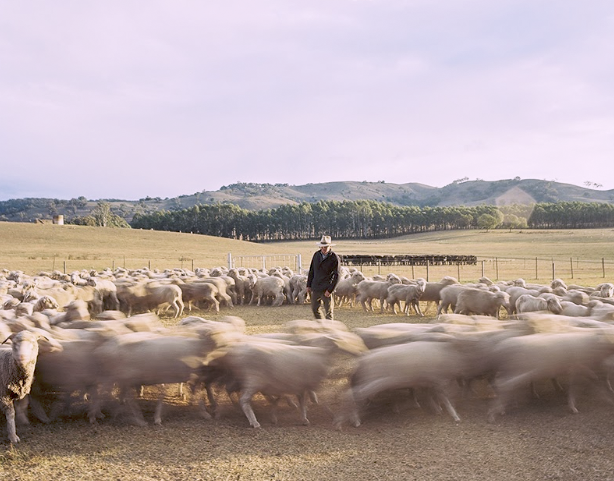
Courtesy of Sol Thompson
In the Study Hotel’s Aisling Gallery, there is an image of a farmer, tracing lines in once-fertile soil with a worn boot. In another image, the haze from burning brush clouds the camera’s eye. In the hotel’s chic lobby, haunting scenes of environmental destruction appear out of place.
But Sol Thompson’s ’21 photos documenting the effects of climate change in Australian agricultural communities provide a stark reminder that some parts of the world are already facing the effects of global warming.
In the summer of 2019, as a member of the YSFP’s 2019 cohort of Global Food Fellows, Thompson used University grants to visit Australian agricultural communities. There, he hoped to capture the consequences of the harsh droughts that have burdened the country since the early 2000s. The proceeds from photo sales will go to the New South Wales Rural Fire Service.
“Rain will come for four or five months, and people will forget that they’ve been in drought for three years, and the cycle repeats,” Thompson explained. “Because of modern advances in agriculture, they’ve been able to soldier their way through. But the land is overworked, it’s very dry. People are starting to move away from rural communities into larger cities because there’s nowhere to work anymore.”
Thompson sees photography as a powerful medium for communicating climate change — one that evokes visceral emotion in its visual imagery.
“When you have a photograph, you have evidence right in front of you,” Thompson said. “Look at this ground, look at this dead sheep. Photos lay the facts in front of you, whether you like it or not. It’s not up for interpretation.” Thompson stressed that written accounts of climate change are still valuable; art is just a necessary supplement to these accounts because it makes large problems feel tangible and real.
Photography as environmentalism is not a new idea. Thompson took inspiration from his family’s history, which intertwines with the American Dust Bowl. In 1937, the Roosevelt administration established the Farm Security Administration, which sought to improve the lives of some rural farmers. The FSA was most well known for its photography program. This program constructed a pictorial record of American life and portrayed the challenges of rural poverty.
Thompson, before embarking on his own project, researched the FSA. He explained that the administration’s “encyclopedia” of agricultural life served both as a documentary and “propaganda to levy support” for the New Deal program.
Chase Westover ’21, a member of the YSFP’s design team, emphasized the importance of art in reframing societal perspectives of issues.
“People don’t like being uncomfortable, and all you have to do is read any article about climate change and it’s very uncomfortable,” Westover said. He said he believes art allows for the incorporation of new ideas into prevailing ones. “When you have the art and the facts together, it can give context and gravity to the situation.”
Westover also commented on art’s power to reconnect observers with nature. Westover is from Texas, and when he is in New Haven, he feels more disconnected from nature — “like the sense of horizon is gone.”
“We’re contained in these spaces,” Westover said. “It feels like people have lost their sense of wonder because of it.”
Mark Bomford, the director of the Yale Sustainable Food Program, addresses the connections between art, agriculture and sustainability in his work. He noted an increased interest at Yale in the intersection between the humanities and ecology, referring to this intersection as an “aesthetics of sustainability.”
“You can’t go looking for the separation between nature and humanity with a microscope because it is entirely something we’ve created,” Bomford said. “[Art] has been there since the beginning, as a source of inspiration and creative uncluttering.”
Yet Bomford critiqued some art in this intersection as “environmental propaganda.”
Bomford said he sees art not as a lens for learning something new about the natural world, but as a tool for unlearning all of the harmful narratives humans have constructed about it.
“If you’re given a particular narrative of what’s natural, what’s not natural, what’s beautiful and what’s not beautiful, what’s sustainable, what’s not sustainable, if you accept those narratives without question, then you’ve been subject to propaganda,” Bomford said.
He added that societal beliefs about what sustainable landscapes are created by the “controlling order” responsible for environmental destruction. He believes that we must question the dominant perception of environmental aesthetics in order to acknowledge the outcomes of a changing climate.
Thompson sees his project as contributing to this questioning. By documenting the experiences of Australian farmers, his photography allows audiences to access narratives they may be geographically isolated from.
“Let’s say someone lives in New York City,” Thompson said. “They get their information through the internet, but they don’t know how bad it’s getting. The ability of art is to move someone from New York to where the photograph puts them.”
Tyler Brown | tyler.james.brown@yale.edu
Correction, Feb. 22: A previous version of this article misstated Bomford’s title as the director of sustainability services at YSFP; in fact, is the director of the program. It also referred to Thompson as a member of the YSFP. In fact, the YSFP does not have members, but Thompson was a member of the YSFP’s 2019 cohort of Global Food Fellows. The article has been updated to reflect this.







